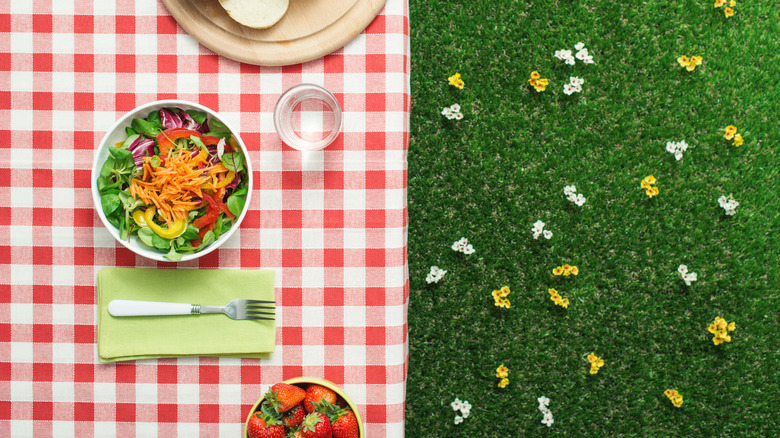The Longest Salad Can Stay Out Before You Probably Shouldn't Eat It
Summer is fast approaching, and along with it comes fun food festivals and excuses for eating outdoors. There's Memorial Day, Independence Day, and Labor Day with their obligatory buffets, not to mention the various neighborhood barbecues and lakeside grill-outs enjoyed in between. Summer salads can save your sanity when you don't feel like cooking, but they're also surefire crowd-pleasers with a healthy potential. (We say potential because that sugary Jello fruit salad with marshmallow fluff isn't earning any health halos, no matter what diet plan you follow.)
When it comes to outdoor eating, though, food safety is a big deal since the fridge isn't within arm's reach. That's true whether you're talking about a wellness salad full of greens or cooked-ingredient variations like a Waldorf chicken salad or classic potato salad.
Fortunately, the most significant food safety rule is easy to remember because it's the same for both kinds of so-called salads. Watch the clock once your salad leaves the fridge to prevent food-borne illness. Time is not on your side regarding the bacterial barrage battling it out in the salad bowl.
The two-hour rule
Bacteria in your food shouldn't disgust you. Our sustenance isn't sterile, nor should it be. We want beneficial bacteria (called probiotics) on our plates and in our guts because they help hone our immune system, break down fiber, and may even improve depression and mood disorders. But it's all about context: we need the right bacteria in the right place to do us good. For example, many strains of E. coli are found in a healthy colon, but certain strains can make us violently ill if we ingest them orally.
The biggest issue with leaving perishable food out at room temperature is providing pathogenic bacteria (the kind that make us sick) a perfect setting to multiply — and quickly. The most common strains of these bad bugs flourish in the temperature danger zone between 40 F and 140 F, which includes room temperature and all your outdoor food-based gatherings (unless you live in Alaska).
The USDA recommends abiding by the two-hour rule for any prepared food, including cut produce and cooked foods. This rule dictates that you either need to eat or refrigerate it within two hours of preparation (whether cutting or cooking). After that point, consuming it could be unsafe even if it still looks and smells fine. Honestly, is it really worth an emergency room trip just to save that last dollop of leftover potato salad?
Smart storage can salvage your salads
To prevent waste of food and preparation efforts, make a game plan for maintaining your salad's temperature if you expect to exceed that two-hour limit. There are countless storage and preservation hacks for cooked or cut foods, but a few are especially suited to outdoor gatherings. First, separate the portions into two or three smaller serving platters instead of presenting one giant platter of your edible offering. That way, you can leave the extra plates in the fridge until the first is finished and replenish as needed.
If a fridge isn't nearby or accessible, another option is laying the serving platter atop a large, shallow bowl of ice. (Chef's trick: add salt to the ice to keep it colder longer.) Or you can use a foldable gel ice pack or even a frozen damp towel for the same effect. The goal would be to keep the salad below 40 F for as long as possible.
A final salad-saving strategy is pre-portioning into individual, disposable containers and placing them in an enclosed cooler. Smaller containers have more surface area in contact with the surrounding cooled air, so they can fare better than large serving dishes where the interior of the food has no contact with the exterior cooling mechanism (like an ice pack). Whichever food storage method you choose, remember to enjoy your de-fridged salads with an eye on time and temperature checks.


